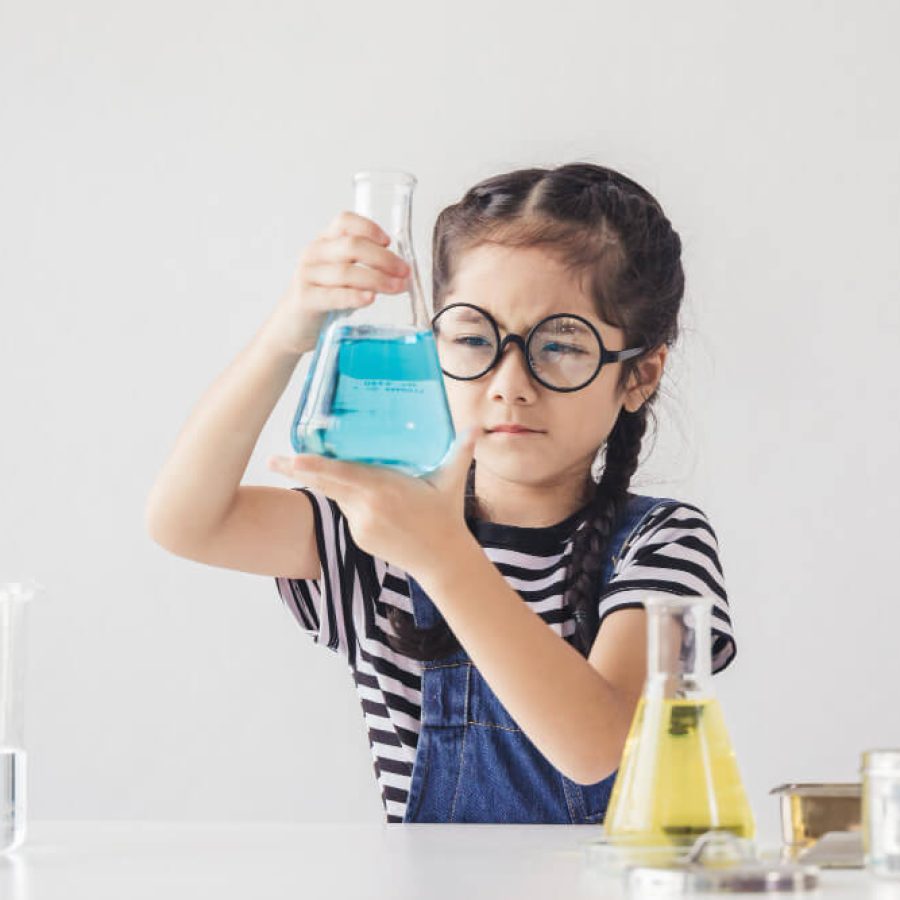Science is a fundamental component of STEAM, one of the most relevant educational methodologies there are! If we want to inspire our children to be curious and understand the world around them, there’s nothing like performing these science experiments.
As children are growing and developing, they’re like little sponges that absorb knowledge coming from all different places. There is no better way to stimulate their imagination and passion for learning than by encouraging them to be curious and explore.
How to Help Your Preschooler Learn to Love STEAM Early
Kids grow up as natural scientists, curious and eager to learn everything about the world around them. Still, why do so many children grow up learning to dislike the sciences? One reason is because we forget to show kids all the ways that science is part of their daily life — and that learning through play is really fun!
At Amazing Explorers, we put together 6 fun science experiments you can do with your preschooler to help them learn to love STEAM early and get ready for the 21st century.
Science Experiments That Preschoolers Will Love
Just remember that even the smartest young scientists need the supervision and guidance of their favorite adult assistant.
Ready? Let’s do science!
Experiment #1: Colorful Carnations
What’s fun about this science experiment is that it doesn’t just talk about biology—it helps kids learn about colors, too!
Materials:
- Some white carnations
- Food coloring
- A clear vase or mason jar for each flower you plan to use
Instructions:
First, fill up your vases a quarter full of water, then put in about 10-20 drops of food coloring. Then the adult assistant will trim each flower before placing them in their own separate vase, preferably by the window.
Ask your scientist to make a hypothesis. What do they think will happen when the flower drinks the water? Then check every few hours on the flowers to see what’s changed. Before 24 hours are up, you should have a colorful new group of carnations!
Bonus: See what happens if you split a flower’s stem in two, then put each side of the stem in different colored mason jars. You might be surprised with how it turns out!
Experiment #2: Groovy Lava Lamp
This hip science experiment is sure to be a hit with your little scientist! It’s also great for discussing chemical reactions and liquid density in a visual, exciting way. Our ingredients are simple household items that you most likely already have available.
Materials:
- Cooking oil
- Water
- Food coloring
- Alka-Seltzer antacid tablets
- An empty water bottle
Instructions:
To make your lava lamp, fill the bottle about two thirds of the way with oil. You’ll want to add just enough water so that there’s still an inch left at the top. Then add a few drops of food coloring—any color you’d like! These will slowly break through the oil and begin to dye the water. Try and wait for that to happen before starting the next step.
Now this is the fun part. Break an Alka-Seltzer tablet into three or four pieces, and watch what happens when you put one (just one!) inside your bottle. Kaboom! It’ll fizz until the tablet completely vanishes in the water, leaving you with one groovy lava lamp.
Experiment #3: Rain Cloud in a Jar
The “rain cloud in a jar” science experiment is a tried and true way of talking about the way the weather works, and also delighting your young scientist.
Materials:
- An empty mason jar
- Shaving cream (not gel-based)
- Food coloring or washable watercolors
- Droppers
- Paper cups
Instructions:
Before your young scientist steps in, the adult assistant has some preparation to do. First, fill the mason jar with water until it’s ¾ full. Then mix the food coloring with some water in a separate, small cup. Put the droppers in each cup of colored water. Finally, put shaving cream in the mason jar until it’s just peeking over the top.
Ready to make your own personal rain cloud? Ask your scientist to squirt colored water from the dropper into the cloudy jar. After two or three times, you should notice the cloud is beginning to “rain” down colorful dye!
So, how does it work? The shaving cream floats in the watery mason jar just like a cloud floats in the air. When the cloud gets too heavy with colorful dye, it “rains” into the jar just like a real rain cloud!
Here are a few experiments.
Experiment #4: Unpoppable Bubbles
You’re never too old to enjoy blowing bubbles! But how cool would it be if they lasted longer? A simple added ingredient does the trick because the bubble film becomes thicker, preventing the water between the soap layers from drying out and popping!
Materials:
- Water
- Dish soap
- Corn syrup, glycerin or plain sugar
- A bowl
- Bubble wand or straw
Instructions:
In a bowl, mix 1 cup of water with 2 tablespoons of dish soap.
Next, add 1 tablespoon of corn syrup, glycerin or sugar to the mixture and stir gently until it’s fully integrated with the mix. This ingredient is key to making the bubbles stronger!
The next steps are a no-brainer: simply dip the bubble wand or a straw into the solution and slowly blow bubbles onto the clean surface.
To make it extra exciting for the young scientists on duty, use a soft woolen glove and try to catch the bubble with your hand! You can also use the wand or a straw to make it sit on the surface without popping.
Experiment #5: Play Doh Volcano
This is a fun experiment to invest in with your child because you get to use their creative skills at assembling the volcano, and also create an eruption with their bare hands!
All it takes is a simple duo of ingredients everyone has at home, vinegar and baking soda. When combined, they produce carbon dioxide gas. Placed on the right surface, you got yourself a homemade volcano!
Materials:
- Play Doh or modeling clay
- Baking soda
- Vinegar
- Food coloring for the “lava” (optional)
- A small container or cup
- A tray or large dish (used to catch the mess)
Instructions:
Use the playdough to shape a volcano around the small container. Make sure the container is open at the top and can hold the ingredients (baking soda and vinegar) for the eruption.
Now it’s time to prepare the volcano! Firstly, place the volcano on a tray to catch any overflow.
Fill the container inside the volcano with 2 tablespoons of baking soda. Then, add a few drops of food coloring to the baking soda.
Pour vinegar into the container until it starts to bubble over the sides and down the volcano!
Experiment #6: Leak-Proof Bag
Now this is something that amazes children of all ages: a pierced-through plastic bag that doesn’t leak? How could that be?!
The secret behind it is a material used in plastic bags called polymers, which are long chains of molecules. When you push the pencil through the bag, the polymer chains stretch but don’t break!
A great addition to the experiment and can be done would be to test different plastic bags and see if they are leak-proof. Also, see what happens when you do find a leak-proof bag and squeeze it while it’s pierced. Just make sure to perform these tests outside, where you have space to get yourself wet!
Materials:
- Ziplock bag
- Sharpened pencils
- Water
- Food coloring (optional)
Instructions:
Fill the Ziplock bag about half to three-quarters full with water and seal it tightly. Next, carefully push a sharpened pencil through one side of the bag and out the other side, making sure it goes through the water. Repeat with several pencils!
Why Should Children Study Science?
Science isn’t just fun — it’s essential to help communities develop in a highly technology-based society!
At Amazing Explorers, we believe that tomorrow’s great minds are in today’s classrooms. That’s why our innovative STEAM learning programs are specifically designed for the 21st century learner, and aimed towards giving them the tools they need to successfully deal with the challenges of the future.
Learning disciplines such as Science, Technology and Mathematics early on, with the right approach, is paramount to grow a positive association with these subjects. Yes, studying Math and other Exact Sciences can be fun!
Your child can learn from a very young age that they are great at analyzing or building objects, or even taking care of other people’s health and pursue a career suited with these skills.
Children then have better chances of choosing careers that combine with the 21st century
After giving it a try at these fun Science experiments, is your scientist ready for adventure? Schedule a tour with us at one of our 20+ locations spread around the country. We’d love to show you how we foster a nurturing environment for the great minds of the 21st century.



